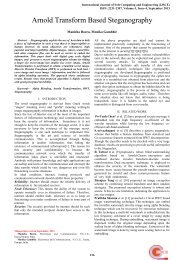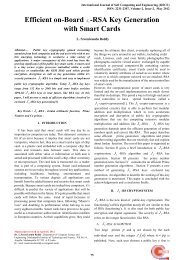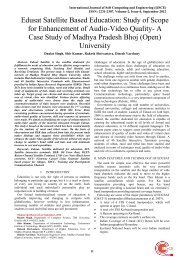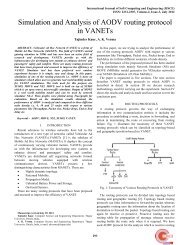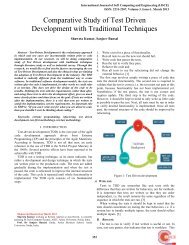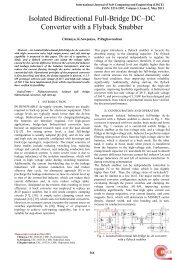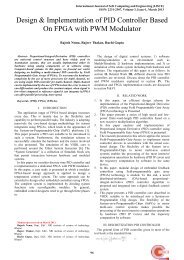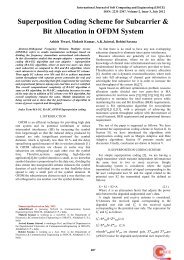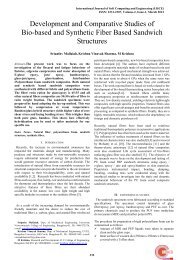Quantum Circuit Automatic Synthesizer(QCAS) - International ...
Quantum Circuit Automatic Synthesizer(QCAS) - International ...
Quantum Circuit Automatic Synthesizer(QCAS) - International ...
Create successful ePaper yourself
Turn your PDF publications into a flip-book with our unique Google optimized e-Paper software.
<strong>International</strong> Journal of Soft Computing and Engineering (IJSCE)<br />
ISSN: 2231-2307, Volume-3, Issue-2, May 2013<br />
<strong>Quantum</strong> <strong>Circuit</strong> <strong>Automatic</strong> <strong>Synthesizer</strong> (<strong>QCAS</strong>)<br />
Ali Moghadaszadeh, Majid Mohamadi, Ali Akbar Niknafs, Peyman Keshavarzian<br />
<br />
Abstract— <strong>Quantum</strong> and reversible circuit synthesis has been<br />
important concern of designers in recently passed decades.<br />
Considering the application of garbage bit in optimization of<br />
quantum circuit, GA-Based techniques have been introduced.<br />
This project provides an extensible infrastructure for quantum<br />
circuit automatic synthesis and optimization with the<br />
enhancement of interoperability features. The problem domain<br />
begins from complex computing model up to a synthesis of<br />
reversible quantum circuit. Optimization criterias are whole<br />
considered separately from software processing logic which cause<br />
capability of applying variable optimization critria in different<br />
problem domains.<br />
The new introduced methodology utilize PSO technique for<br />
circuit synthesis evolutionary computation in optimization step. A<br />
software library has been developed which implements this<br />
technique.<br />
It provides a simple flexible software for researchers in order to<br />
automatic synthesis of quantum circuit that implements an open<br />
source library of prerequisite of quantum circuit synthesis.<br />
Index Terms-<strong>Quantum</strong> circuits, gate, PSO, <strong>Automatic</strong><br />
synthesis.<br />
I. INTRODUCTION<br />
Synthesis of reversible logic circuit is very different from<br />
classical logic circuit. The output capacity of reversible gate<br />
is supposed to be one [1]. The common gates like “AND” and<br />
“OR” cannot be applied in reversible circuit synthesis process<br />
because of irreversible nature.<br />
Considering reversible characteristics of quantum circuits,<br />
synthesis process differs from classical and reversible logic.<br />
The reasons are variety of quantum gates, distinct<br />
representation model and properties like entanglement or<br />
superposition in quantum circuits [2].<br />
Therefore, the synthesis methods of reversible circuits are<br />
used only for a certain set of quantum circuits. It is possible to<br />
use insignificant values in corresponding input and output<br />
vectors of truth table to optimize the circuit [3].<br />
Extra inputs and garbage outputs which are insignificant<br />
values for result function may cause a simpler circuit with<br />
lower synthesis cost [4].<br />
<strong>Circuit</strong> optimization is considered with different aspects, e.g.<br />
criteria such as quantum cost, number of constant inputs and<br />
garbage outputs and the distance between control inputs and<br />
goal output are used for comparing reversible and quantum<br />
circuits. The major objective is to provide a method that can<br />
automatically find the best way to optimize different aspects<br />
of reversible and quantum circuits [5]- [7].<br />
Manuscript received April, 2013.<br />
Ali Moghadaszadeh, Computer Engineering Department, Science and<br />
Research branch, Islamic Azad University, Kerman, Iran<br />
Majid Mohamadi, Computer Engineering Department, Shahid Bahonar<br />
University of Kerman, Kerman, Iran.<br />
Ali Akbar Niknafs, Computer Engineering Department, Shahid Bahonar<br />
University of Kerman, Kerman, Iran.<br />
Peyman Keshavarzian, Computer Engineering Department, Science and<br />
Research branch, Islamic Azad University, Kerman, Iran.<br />
The rest of the paper is organized as follows: Section II<br />
introduces <strong>QCAS</strong>. Section III presents Experimental Results<br />
Finally, section IV concludes the paper.<br />
II. <strong>QCAS</strong><br />
We will address the problem of quantum circuit automatic<br />
synthesis given a desired truth table. The automatic circuit<br />
synthesis problem is considered as a computing problem of<br />
optimization and quantum computation.<br />
The framework structure represented in Fig.1, includes 5<br />
main components named “Process Controller”, “PSO Actor”,<br />
“QCL”, “Model Convertor” and “Visualizer”. We will<br />
explain each Component in detailed below.<br />
Fig.1: The general structure of <strong>QCAS</strong> software<br />
A. Process Controller<br />
Process Controller agent manages whole process of quantum<br />
circuit synthesis. It provides initial states for other actors in<br />
the system. Initial variables like process time, maximum<br />
iteration and maximum inertia are initiated in this module.<br />
Controller adapts process parameters by back-tracking and<br />
assigning values to some parameters in stochastic manner. It<br />
dispatches events and information from PSO Actors to<br />
Visualizer. It also prepares input model from a user-defined<br />
truth table to a reversible by adding don’t care values.<br />
B. PSO Actor<br />
This component provides functions and classes which are<br />
used to apply PSO algorithm on automatic quantum circuit<br />
synthesis problem in order to optimize the result.<br />
With regards to comprehensive features of this actor, it is<br />
possible to utilize software library of classes developed in this<br />
section for other problem domains. The application technique<br />
of PSO Actor in a quantum circuit synthesis is depicted in<br />
Fig.2 as an abstract model.<br />
412
<strong>Quantum</strong> <strong>Circuit</strong> <strong>Automatic</strong> <strong>Synthesizer</strong> (<strong>QCAS</strong>)<br />
Fig.2: PSO employment in solution<br />
Synthesis of classical reversible or quantum circuit with<br />
application of PSO technique requires a coding approach<br />
which represents gate positions and states on a circuit [8].<br />
As reversible circuits, quantum circuits have equal inputs and<br />
outputs. So we considered plane and section representation<br />
method (Fig.3) for coding a quantum circuit to particle<br />
positions in PSO.<br />
Fig.3: Display model of Plane and Section for quantum<br />
circuits<br />
A gate position is converted to a particle position by structure<br />
which is shown in Fig.4, each gate input is mapped to a plane.<br />
The gate kind is obtained by an integer number that points to<br />
that gate in the possible gate collection list.<br />
Fig.4: Coding of circuits into particles position in PSO<br />
method<br />
In (1), maximum allowed gate count named GL with<br />
maximum gate input named X, we obtain GL * (X+1)<br />
dimensions for particle position space.<br />
n=(X+1)×GL,<br />
(1)<br />
X=max(InputCount(G)), GL=GateLevel<br />
Remember the PSO workflow [9], the velocity of particles are<br />
updated as (2).<br />
(2)<br />
V = K × [ V ( p ) × D ( w ) + [ ( Best ( position ( p ) ) - position ( p ) )<br />
( p )<br />
i<br />
× CA × D ( r ) ] + [ ( Best ( position ( i , p ) ) - position ( p ) ) × SA × D ( r ) ]<br />
1 2<br />
i = Iteration , r = Random , SA = Social Acceleration, P =Particle<br />
1<br />
D = Discret Probability Function ,<br />
CA = Cognitive Acceleration<br />
Like GA-Based techniques in quantum circuit synthesizing<br />
[10] by employing mutation operator to change position of a<br />
particle in one dimension suddenly, we can improve particle<br />
chance to see new positions.<br />
We also used a velocity tuner called VTU that improves<br />
algorithm performance by reduction of invalid space which<br />
particles meet them. It prevents particles to move out from<br />
PSO search space boundary.<br />
Some positions where particles moving to, are not a valid<br />
position in PSO search space because of the impossibility of<br />
realization e.g. a position like “1,1,1,1” is invalid position<br />
because all input of gate is located on a same Plane which its<br />
index is “1”.<br />
Fitness function determination is a challenging problem and<br />
mostly related to optimization criteria.<br />
We applied an object oriented fitting technique. Events called<br />
“OnMeasure” and “OnFit” are raised when PSO Actor needs<br />
to evaluate each particle position in order to update internal<br />
variables. Events are dispatched to evaluators which are<br />
assigned to this process.<br />
External SDK developments can easily participate in<br />
evaluating metric and fitness of particles that are indeed<br />
coded circuits.<br />
Here Metric structure is introduced to propel process to an<br />
optimized space, e.g. Target Control Distance (TCD) could<br />
be considered as metric.<br />
“OnFit” causes more fitted result and “OnMeasure” directs to<br />
best metrics. More fitted result means the result which it is<br />
possible circuit that obeys the preferred input and output<br />
model such as zero hamming distance of circuit output with<br />
expected one.<br />
C. QCL<br />
<strong>Quantum</strong> <strong>Circuit</strong> computing Logic which is briefly called<br />
“QCL” is main computing agent to evaluate output function of<br />
circuit as sequence of quantum gate. QCL has two level<br />
computations, one is considered as Gate Level and the other<br />
one as circuit level (plane level). Gate Level computation is<br />
handled by internal corresponding matrix in each gate that<br />
effectively computes outputs of a quantum gate after applying<br />
a custom input state. Second level computation (plane level)<br />
affects the gate outputs on total circuit state in a specific index<br />
in sequence. Each quantum state is represented by (3):<br />
φ=α. 0 +β. 1<br />
(3)<br />
2 2<br />
α + β =1<br />
Since QCL shall be able to compute φ , so we consider “QS”<br />
as:<br />
Struct QS<br />
{<br />
AlfaReal<br />
AlfaComplex<br />
BetaReal<br />
BetaImaginary<br />
}<br />
<strong>Circuit</strong> as sequence of quantum gate maintains QS for each<br />
qubit and takes aware of gate effect at sequence stages.<br />
By affecting first level computation, new qubit states are<br />
obtained, it goes on till output function to be computed, as<br />
413
<strong>International</strong> Journal of Soft Computing and Engineering (IJSCE)<br />
ISSN: 2231-2307, Volume-3, Issue-2, May 2013<br />
described in (4), circuit state is initiated by an initial quantum<br />
state and last to final quantum state.<br />
(4)<br />
n n n n<br />
QS initial (n,double[2 ],double[2 ]) QS(n,double[2 ],double[2 ])<br />
“n” is count of plane in representing model. A quantum circuit<br />
with “n” plane requires a matrix by 2 n rows, in order to<br />
describe circuit state in “kth” stage of computation.<br />
<strong>Quantum</strong> states are represented by a matrix like (5):<br />
0<br />
<br />
1<br />
2<br />
P <br />
<br />
3<br />
<br />
<br />
.<br />
<br />
<br />
n<br />
2 1<br />
<br />
<br />
<br />
<br />
<br />
<br />
<br />
<br />
<br />
<br />
(5)<br />
n<br />
n<br />
a =x+yi x:Matrix(2 ,1) y:Matrix(2 ,1)<br />
j<br />
QCL detaches “P” into two different matrixes to simplify<br />
complex computation of<br />
, that hides symbol “i”<br />
α ,…,α<br />
0 n 2 -1<br />
in preserving complex matrixes.<br />
“P” has a growth function of ( Ω (2 n )), if n=2 or n=3 the<br />
matrix is in dimension of 4 or 8 but for n=32 it would be 2 32 ,<br />
that is massive to store and computing that results to lower<br />
performance.<br />
It suffers from resource consumption problem. To overcome<br />
this problem. We consider only significant states which are<br />
distinguished by none-zero value in imaginary or real part<br />
rows of matrixes.<br />
Fig.5: QCL data structure used to store the quantum circuit<br />
If quantum circuit is simultaneously in “ η ” different quantum<br />
n<br />
state (0< η
<strong>Quantum</strong> <strong>Circuit</strong> <strong>Automatic</strong> <strong>Synthesizer</strong> (<strong>QCAS</strong>)<br />
Applying VTU (Velocity Tuner) the average valid space ratio<br />
is improved and almost being constant by Gate Level growth<br />
(Fig.11).<br />
Fig.7: Improved One-bit full adder (reversible gates)<br />
Result (Fitness=1, Metrics=10,8,2)<br />
Metric selector in PSO Actor, selects best metric by ordering<br />
logic specified in initial parameter definition table (Table.1).<br />
Metrics were considered as quantum cost, TCD (Target<br />
Control Distance) and CCD (Control-Control Distance).<br />
Results with less metric measures are obviously better results.<br />
Fig.7 shows circuit which its metrics are improved in<br />
comparison to Fig.6 by reduction of CCD.<br />
The same circuit in Figs.6,7 is synthesized by quantum gates<br />
in Fig.8.<br />
Fig.11: PSO valid space usage<br />
According to Fig.12, VTU causes a considerable reduction of<br />
algorithm response time.<br />
Fig.8: One-bit full adder (quantum gate)<br />
It is improved by quantum cost,TCD and CCD in Fig.9<br />
Fig.12: Response time<br />
Fig.9: Improved One-bit full adder (quantum gate)<br />
VTU affects the performance of algorithm by decreasing<br />
about 52% of the iteration count that illustrated in Fig.13.<br />
PSO particles may meet PSO search space positions more<br />
than once and also some of them are inherently invalid<br />
positions that could not represent a circuit by QCL. mAs<br />
Fig.10 shows, duplication ratio is increased when Gate Level<br />
growth. Reversely valid space is decreased by Gate Level<br />
growth.<br />
Fig.13: Iteration<br />
Fig.10: PSO space usage<br />
IV. CONCLUSION<br />
In this paper we explained synthesis and optimization of<br />
reversible quantum circuits in a logical manner. We detach<br />
synthesis problem into logical operational agents. The<br />
process of synthesizing is handled by agent interactions,<br />
although GA_Based methods have been already applied for<br />
quantum and mostly reversible circuit automatic synthesis, we<br />
utilized PSO algorithm. A flexible software framework<br />
developed for managing interaction of individual modules in<br />
synthesis process also an object oriented view of optimization<br />
415
<strong>International</strong> Journal of Soft Computing and Engineering (IJSCE)<br />
ISSN: 2231-2307, Volume-3, Issue-2, May 2013<br />
criteria was employed which makes it possible to take<br />
advantage of physical quantum simulators in case of metrics<br />
in finding optimum result. Metric objects are passed to<br />
evaluators by the internal event dispatcher in controller agent<br />
then forwarded to optimizer agent in order to be applied in<br />
heuristic search computation. Dynamic fitness evaluators,<br />
no-limited metrics and various gate definition capabilities are<br />
important features of this framework.<br />
Controller module tunes adaptive parameters of synthesis in<br />
each cycle of iterations and uses back-track operation, so it<br />
strengthens the optimizer module by providing different<br />
configuration and initialization at start time.<br />
VTU (Velocity Tuner) cause a considerable improvement in<br />
algorithm performance and expected response time.<br />
REFERENCES<br />
[1] Miller, D.M., Dueck, G.W., Maslov, D., “A Transformation Based<br />
Algorithm for Reversible Logic Synthesis”, Proceedings of the 40th<br />
Design Automation Conference, Anaheim, CA, pp. 318–323, 2003.<br />
[2] Peres, A.: “Reversible Logic and <strong>Quantum</strong> Computers”, Physical<br />
Review, A 32: 3266–3276, 1985.<br />
[3] Prathibha, T.R., Bhagyalakshmi, H.R., Venkatesha, M.K., “Optimized<br />
Reversible carry select BCD adders using Reversible logic gates”,<br />
Computer Technology & Applications,Vol 3 (4), 1550-1556, IJCTA,<br />
July-August 2012.<br />
[4] Mohammadi, M., Eshghi, M., “Heuristic Methods to use don’t cares in<br />
automated design of reversible and quantum logic circuits”, <strong>Quantum</strong><br />
Information Processing , Springer, Volume 7, Issue 4 (August 2008)<br />
pp.175 - 192.<br />
[5] Donald, J., JHA, N., “Reversible Logic Synthesis with Fredkin and<br />
Peres Gates”, ACM Journal on Emerging Technologies in Computing<br />
Systems, Vol. 4,No. 1, Article 2, March 2008.<br />
[6] Maslov, D., Dueck, G.W., Miller, M., Negrevergne, C., “<strong>Quantum</strong><br />
<strong>Circuit</strong> Simplification and Level Compaction”, IEEE Transactions on<br />
Computer-Aided Design of Integrated <strong>Circuit</strong>s and Systems,<br />
27(3):436–444, March 2008.<br />
[7] Wille, R., Drechsler R., “BDD-based Synthesis of Reversible Logic for<br />
Large Functions”, DAC, San Francisco, California, USA, July 26-31,<br />
2009.<br />
[8] Ogri. J., Etim, O., prosper, I., “ Optimising digital combinational<br />
circuit using particle swarm optimisation technique”, Lat. Am. J. Phys.<br />
Educ. Vol. 6, No. 1, March 2012.<br />
[9] Zhong, Y., Shuzhi, N., “An Improved Particle Swarm Optimization<br />
Algorithm based on Membrane Structure”, IJCSI <strong>International</strong> Journal<br />
of Computer Science Issues, Vol. 10, Issue 1, No 2, 2013.<br />
[10] Ruican, C., Udrescu, M., Prodan, L., Vladutiu, M., “Genetic Algorithm<br />
Based <strong>Quantum</strong> <strong>Circuit</strong> Synthesis with Adaptive Parameters”, CEC’09<br />
“IEEE Congress on Evolutionary Computation”, Trondheim, Norway,<br />
May 2009, pp. 896-903, ISBN 978-1-4244-2959-2.<br />
[11] Patel, K., Markov, I., Hayes, P., “Optimal Synthesis Of Linear<br />
Reversible <strong>Circuit</strong>s”, <strong>Quantum</strong> Information and Computation, Vol. 8,<br />
No. 3&4 (2008) 0282–0294.<br />
416



